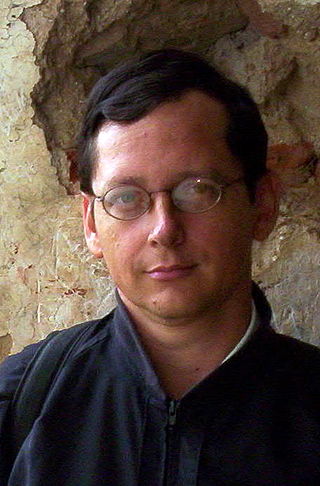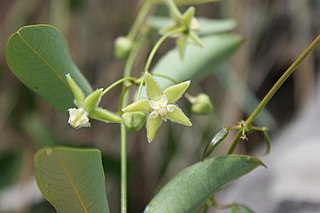Related Research Articles

The Smithsonian Tropical Research Institute is located in Panama and is the only bureau of the Smithsonian Institution based outside of the United States. It is dedicated to understanding the past, present, and future of tropical ecosystems and their relevance to human welfare. STRI grew out of a small field station established in 1923 on Barro Colorado Island in the Panama Canal Zone to become one of the world's leading tropical research organizations. STRI's facilities provide for long-term ecological studies in the tropics and are used by some 1,200 visiting scientists from academic and research institutions around the world every year.
Redonda is a butterfly genus from the subfamily Satyrinae in the family Nymphalidae. The genus was erected by Michael Jan Adams and George Igor Bernard in 1981. It is endemic to the Cordillera de Merida páramo in Mérida, Venezuela. There are 10 known species, which are separated in distinct mountain ranges. Most species show some degree of sexual dimorphism in wing size, in the most extreme cases females show some degree of wing deformation which might point to incipient brachyptery.

Cracker butterflies are a Neotropical group of medium-sized brush-footed butterfly species of the genus Hamadryas. They acquired their common name due to the unusual way that males produce a "cracking" sound as part of their territorial displays. The most comprehensive work about their ecology and behavior is that of Julian Monge Najera et al. (1998). The genus was erected by Jacob Hübner in 1806.

Hedylidae, the "American moth-butterflies", is a family of insects in the order Lepidoptera, representing the superfamily Hedyloidea. They have traditionally been viewed as an extant sister group of the butterfly superfamily Papilionoidea. In 1986, Scoble combined all species into a single genus Macrosoma, comprising 35 currently recognized and entirely Neotropical species, as a novel concept of butterflies.

Agrias is a genus of Neotropical charaxine nymphalid butterflies found in South and Central America.

The Elymniini is one of the tribes of the subfamily Satyrinae. If the subfamily Satyrinae elevate to family status, this tribe shall be treated as subfamily Elymniinae. Elymniini was formerly a large group, but recently, it is considered to be include only one genus, Elymnias, according to molecular phylogenetic analyses.

The butterfly subtribe Euptychiina is a diverse group within the tribe Satyrini, occurring throughout Central and South America, in addition to a few species known from North America. Euptychiina is a predominantly lowland group, with the exception of one Asian taxon Palaeonympha opalinaButler, 1871 and the Andean genus ForsterinariaGray, 1973. The taxon was erected by Lee Denmar Miller.

Philip James DeVries is a tropical biologist whose research focuses on insect ecology and evolution, especially butterflies. His best-known work includes symbioses between caterpillars, ants and plants, and community level biodiversity of rainforest butterflies.

Junonia evarete, the tropical buckeye or South American tropical buckeye, is a South American butterfly of the nymphalid (Nymphalidae) family. It has characteristic eye spots on the wings, which have a wingspan between 4.5 and 6.5 cm. This butterfly is easily confused with Junonia genoveva, the mangrove buckeye. Not only have the common names mangrove and tropical buckeye been confused, but the butterflies themselves have been sometimes misidentified in past literature because the two species have many variations, subspecies and seasonal forms, which makes them difficult to identify or differentiate. Phylogenetic studies demonstrate the separation of evarete and genoveva, but evidence suggests that subspecies and perhaps more species await their descriptions within this group.

The Liquid Jungle Lab (LJL) is a tropical marine research station on the island of Canales de Tierra on the western coast of Pacific Panamá along a primary marine biological corridor. The LJL research campus was completed in 2004 and is part of a private 3,500 hectare reserve composed of primary forest, mangroves, tide pools, and a rocky inter-tidal zone that transitions into fringing coral reefs.
Olga Francesca Linares was a Panamanian–American academic anthropologist and archaeologist, and senior staff scientist (emerita) at the Smithsonian Tropical Research Institute (STRI) in Panama, who have supported much of her research throughout her career. She is well known for her work on the cultural ecology of Panama, and more recently in the Casamance region of Southern Senegal. She is also concerned with the social organization of agrarian systems as well as the relationship between "ecology, political economy, migration and the changing dynamics of food production among rural peoples living in tropical regions".

Julián Monge-Nájera (born June 6, 1960, in San José is a Costa Rican ecologist, scientific editor, educator and photographer. He has done research with the following institutions: Universidad de Costa Rica, Smithsonian Tropical Research Institute, and Universidad Estatal a Distancia. His scientific work has been featured by The New York Times; National Geographic Magazine; the BBC; Wired; IFLoveScience; The Independent and The Reader's Digest, among others. He is a member of the Expert Panel that sets the Environmental Doomsday Clock; Onychophora Curator in the Encyclopedia of Life; and Team Member of the IUCN Red List of Threatened Species.
Charaxes druceanus, the silver-barred emperor or silver-barred charaxes, is a butterfly of the family Nymphalidae. It is found throughout tropical Africa.

Ira Rubinoff is an American marine biologist and was a former director of the Smithsonian Tropical Research Institute in Panama.
Porthecla annette is a butterfly in the family Lycaenidae. It is found in Panama and central Colombia at altitudes under 1,000 meters.

Blepharodon is a genus of plant in the family Apocynaceae, first described as a genus in 1844. They are native primarily to South America, with one species extending into Central America and Mexico.

Carla Maria Penz is a butterfly comparative morphologist and systematist, and the Doris Zemurray Stone Chair in Biodiversity at the University of New Orleans. Her research also focuses on natural history and behavior, mostly of neotropical butterflies.
Ooencyrtus marcelloi is a parasitic wasp belonging to the family Encyrtidae. The species was first discovered in 2008 in a tropical lowland rainforest in the Soberanía National Park around Gamboa, Panama. The scientific name was first published in 2010.
Egbert Giles Leigh, Jr. is an evolutionary ecologist who spends much of his time studying tropical ecosystems. He is a researcher for the Smithsonian Tropical Research Institute and is well known for the work he has done on Barro Colorado Island. He is a US citizen, but has resided at the Smithsonian in Panama for nearly 50 years. Along with studies on Barro Colorado Island, Leigh is also known for the research he has done related to the Isthmus of Panama and its historical significance on the evolution of South American species.

Leonila Vázquez García, known as Leonila Vázquez, was a Mexican entomologist and awardee of the Mexican Entomology Society's 1971 Entomological Merit medal. She is known for the study of the biology of the cochineal, an insect species used to create the red dye carmine. She was also a renowned butterfly researcher, contributing the first butterfly section to the Encyclopedia of Mexico and describing 39 new species to science throughout her career.
References
- ↑ "Annette Aiello - Staff Scientist". stri.si.edu. Smithsonian Tropical Research Institute. 14 August 2011. Archived from the original on 2011-08-14. Retrieved 25 June 2020.
- ↑ "INNOVA: Maravillosas 'alas con escamas'". Prensa.com (in Spanish). 10 October 2012. Archived from the original on 2012-10-10. Retrieved 25 June 2020.
- ↑ "Short Biography of Annette Aiello, Smithsonian Tropical Research Institute" (PDF). cfa.harvard.edu. Retrieved 25 June 2020.
- ↑ Aiello, Annette. "Annette Aiello - CV" (PDF). Archived (PDF) from the original on 2019-10-05. Retrieved 2020-06-26.
- ↑ NiekraszEJ (2020-02-05). "Annette A. Aiello". Smithsonian Institution Archives. Retrieved 2020-06-26.
- 1 2 3 4 Smithsonian Tropical Research Institute (2016-09-22). "Annette Aiello: Research Focus". Smithsonian Tropical Research Institute. Retrieved 2020-06-25.
- ↑ King, Elisabeth. "Females in Flatland". www.smithsonianmag.com. Retrieved 2020-06-26.